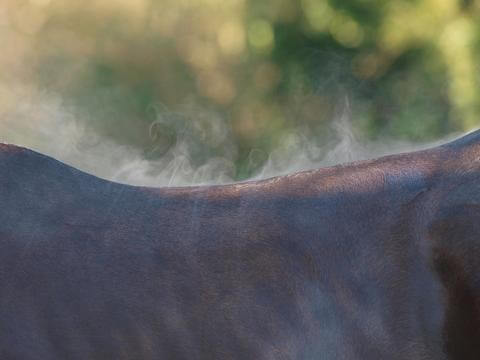As our country continues to bask in an unusually long heatwave, our horses health and welfare continues to be at the forefront of our minds. But how well do they cope in the heat? Equine Scientist and Haygain consultant Andrea Ellis investigates.
“Horses can self-regulate their temperature with ease (in that they do not use excess energy doing so) between -3°C and 18°C). When the temperature rises 5°C over that maximum (anywhere higher than 23°C) they tend to slow down their natural behaviours to avoid over-heating.”

feeling hot, hot, hot.
It takes horses two weeks to acclimatise to excessively hot weather or working continuously in warmer than normal conditions. That being said, they’re still going to show signs of heat exhaustion even if they’re used to it. Horses lose a lot of electrolytes when they sweat profusely so it’s best to provide this as a supplement to their daily ration to ensure they’re salt levels are kept at a suitable level.
It must also be noted that high humidity prevents efficient sweat evaporation meaning overheating is increasingly common. If you can’t avoid your training sessions or competitions, be sure to wash your horse off after exercise and position a fan (at a safe distance) in front of your horse to help cool them down quicker. Be vigilant – if your horse starts to trip or leans heavily on the forehand, stop and check they’re not dehydrated.
“There are 5 key signs of heat stress,” says Andrea. “Increased respiratory rate, increased respiratory depth, low head carriage, flared nostrils and refusal to eat or drink are all vital signs. Dehydration must be avoided. You can check your horse isn’t dehydrated by pinching the skin on the neck. If the skin doesn’t return to lying flat immediately, this is called skin tenting and is a clear sign of dehydration.”
How to rehydrate your horse
If your horse is showing any of the above signs, immediately try to encourage them to drink room temperature water. Keep an eye on their internal temperature (which should never exceed 39°C). Unfortunately, you can lead a horse to water, but you can’t make them drink! Try adding apple juice to their water to help encourage them to drink and offer them a small feed.
“Start by offering a sloppy sugar-beet feed or bran mash. The water content in this should help to rehydrate your horse. Once they’ve eaten a small feed or drank some liquid, provide some steamed forage. Eating forage actually produces heat from the digestion process so ensure the horse is rehydrated before you offer it.”
Offering steamed hay is a good way to increase the water content and to help reduce the likeliness of your horse being dehydrated in the first place. A study in conjunction with Haygain by Earing et al. (2013) found that horses consumed nearly 3 times the water content when fed steamed hay compared to the dry alternative.
For more information please visit www.haygain.com. With thanks to Andrea Ellis for her knowledge and input in this article.
Search
Recent Articles
- How to take a horse from SHOES to BAREFOOT with Alex Ridgeway & Dr Mark Caldwell
- 8 Laminitis Myths Busted!
- I’ve learnt as I’ve got older to really listen to what the people around me say about others
- The dangers of sleep deprivation in horses
- The third part of our series on stretching and flexibility with Sharon Stuart or Stuart Equine – forelimb and neck stretches for the horse and shoulder stretches for the rider
Categories
- Advice Hub
- Athlete
- Carriage Driving
- Dentistry
- Dressage
- Endurance
- Eventing
- Farrier
- Featured
- Featured Horse Ads
- Featured Posts
- Horse Racing
- Horse's Mouth
- Horseball
- Hunting
- Le Trec
- Leisure Riders
- Mounted Games
- Nutrition
- Polo
- Polocrosse
- Reining
- Rescue & Rehabilitation
- Show Jumping
- Showing
- Tack Room
- Team Chasing
- The Pony Club
- Therapy
- Training
- Vaulting
- Veterinary




